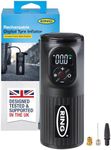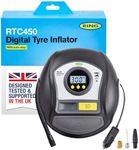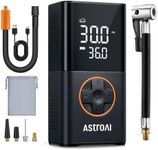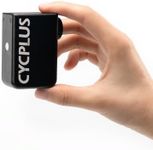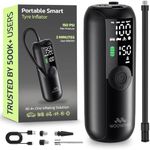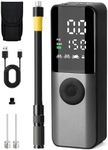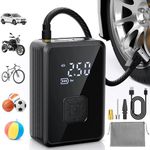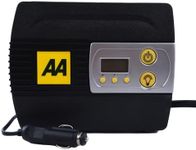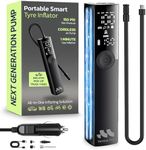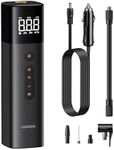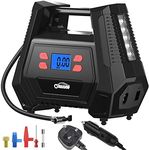Buying Guide for the Best Electric Bicycle Pump
Choosing the right electric bicycle pump can make a significant difference in maintaining your bike's tire pressure and ensuring a smooth ride. When selecting an electric bicycle pump, it's important to consider several key specifications that will help you find the best fit for your needs. Understanding these specifications will guide you in making an informed decision and ensure that the pump you choose is both efficient and convenient for your biking routine.Pressure CapacityPressure capacity refers to the maximum amount of air pressure the pump can deliver, measured in PSI (pounds per square inch). This is important because different types of bicycle tires require different pressure levels. For example, road bikes typically need higher pressure (80-130 PSI), while mountain bikes require lower pressure (30-50 PSI). Choose a pump with a pressure capacity that matches the requirements of your bike tires.
Power SourceElectric bicycle pumps can be powered by various sources such as rechargeable batteries, car cigarette lighters, or direct AC power. The power source is important because it affects the pump's portability and convenience. Battery-powered pumps are highly portable and great for on-the-go use, while those that plug into a car or wall outlet may offer more power but are less portable. Consider where and how you plan to use the pump to determine the best power source for you.
Inflation SpeedInflation speed indicates how quickly the pump can inflate a tire, usually measured in minutes. This is important for efficiency, especially if you need to inflate multiple tires or are in a hurry. Faster pumps can save you time, but they may also be noisier. If you value speed, look for pumps with higher inflation rates. If noise is a concern, you might prefer a slightly slower, quieter model.
Display TypeThe display type on an electric bicycle pump shows the current pressure level and other settings. Displays can be analog (with a needle gauge) or digital (with an LCD screen). Digital displays are generally easier to read and more accurate, especially in low light conditions. If precision and ease of use are important to you, opt for a pump with a digital display.
Auto Shut-OffAuto shut-off is a feature that automatically stops the pump when the desired pressure is reached. This is important for preventing over-inflation, which can damage your tires. Pumps with auto shut-off are more convenient and user-friendly, as they allow you to set the desired pressure and let the pump do the rest. If you want a hassle-free experience, look for a pump with this feature.
Size and PortabilitySize and portability refer to the physical dimensions and weight of the pump. This is important if you plan to carry the pump with you on rides or need to store it in a small space. Smaller, lighter pumps are easier to transport but may have lower pressure capacity or slower inflation speeds. Consider how and where you will use the pump to determine the right balance between size and functionality.
CompatibilityCompatibility refers to the pump's ability to work with different types of valve stems, such as Presta and Schrader valves. This is important because using the wrong type of pump can make inflation difficult or impossible. Some pumps come with adapters to fit multiple valve types. Ensure the pump you choose is compatible with your bike's valve stems to avoid any issues.
